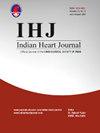通过肺超声b线检查定义的残余肺充血定量预测急性心力衰竭心血管事件:一项系统回顾和Meta分析
IF 1.8
Q3 CARDIAC & CARDIOVASCULAR SYSTEMS
引用次数: 0
摘要
背景:肺超声(LUS)检测肺充血已成为急性心力衰竭(AHF)有价值的预后指标。本系统综述和荟萃分析旨在评估出院前LUS鉴定的残留b线的预后意义。方法:综合检索PubMed、Cochrane Library、ScienceDirect和ClinicalTrials.gov的文献,检索时间截止到2024年10月4日。评估住院AHF患者残留b线与不良临床结果之间关系的研究被纳入,而涉及门诊评估的研究被排除。主要终点是全因死亡率和心力衰竭再住院的综合结果。次要结局包括全因死亡率和心衰再住院。计算合并风险比(hr)和95%置信区间(ci)。结果:纳入15项研究。残留b线与复合结局风险增加显著相关(HR: 2.32;95% CI: 1.91-2.82),全因死亡率(HR: 3.01;95% CI: 1.91-4.73),心衰再入院或心血管事件(HR: 4.01;95% ci: 2.22-7.24)。风险随着b线负担的增加而增加。短期随访对预后的影响更大(结论:出院时LUS评估的残余肺充血是不良结局的一个强有力的独立预测因素,可以指导AHF管理的治疗决策。本文章由计算机程序翻译,如有差异,请以英文原文为准。
Quantification of residual pulmonary congestion defined by B-line findings on lung ultrasound to predict cardiovascular events in acute heart failure: A systematic review and meta analysis
Background
Pulmonary congestion detected by lung ultrasound (LUS) has emerged as a valuable prognostic marker in acute heart failure (AHF). This systematic review and meta-analysis aimed to evaluate the prognostic significance of residual B-lines identified by LUS before hospital discharge.
Methods
A comprehensive literature search of PubMed, Cochrane Library, ScienceDirect, and ClinicalTrials.gov was conducted up to October 4, 2024. Studies assessing the association between residual B-lines and adverse clinical outcomes in hospitalized AHF patients were included, while studies involving ambulatory assessments were excluded. The primary outcome was a composite of all-cause mortality and heart failure (HF) rehospitalization. Secondary outcomes included all-cause mortality and HF rehospitalization individually. Pooled hazard ratios (HRs) with 95 % confidence intervals (CIs) were calculated.
Results
Fifteen studies were included. Residual B-lines were significantly associated with an increased risk of composite outcomes (HR: 2.32; 95 % CI: 1.91–2.82), all-cause mortality (HR: 3.01; 95 % CI: 1.91–4.73), and HF readmission or cardiovascular events (HR: 4.01; 95 % CI: 2.22–7.24). Risk increased with greater B-line burden. Prognostic impact was stronger in short-term follow-up (<6 months; HR: 3.57) than in longer-term follow-up (≥6 months; HR: 1.96).
Conclusions
Residual pulmonary congestion assessed by LUS at discharge is a strong independent predictor of adverse outcomes and may guide therapy decisions in AHF management.
求助全文
通过发布文献求助,成功后即可免费获取论文全文。
去求助
来源期刊

Indian heart journal
CARDIAC & CARDIOVASCULAR SYSTEMS-
CiteScore
2.60
自引率
6.70%
发文量
82
审稿时长
52 days
期刊介绍:
Indian Heart Journal (IHJ) is the official peer-reviewed open access journal of Cardiological Society of India and accepts articles for publication from across the globe. The journal aims to promote high quality research and serve as a platform for dissemination of scientific information in cardiology with particular focus on South Asia. The journal aims to publish cutting edge research in the field of clinical as well as non-clinical cardiology - including cardiovascular medicine and surgery. Some of the topics covered are Heart Failure, Coronary Artery Disease, Hypertension, Interventional Cardiology, Cardiac Surgery, Valvular Heart Disease, Pulmonary Hypertension and Infective Endocarditis. IHJ open access invites original research articles, research briefs, perspective, case reports, case vignette, cardiovascular images, cardiovascular graphics, research letters, correspondence, reader forum, and interesting photographs, for publication. IHJ open access also publishes theme-based special issues and abstracts of papers presented at the annual conference of the Cardiological Society of India.
 求助内容:
求助内容: 应助结果提醒方式:
应助结果提醒方式:


